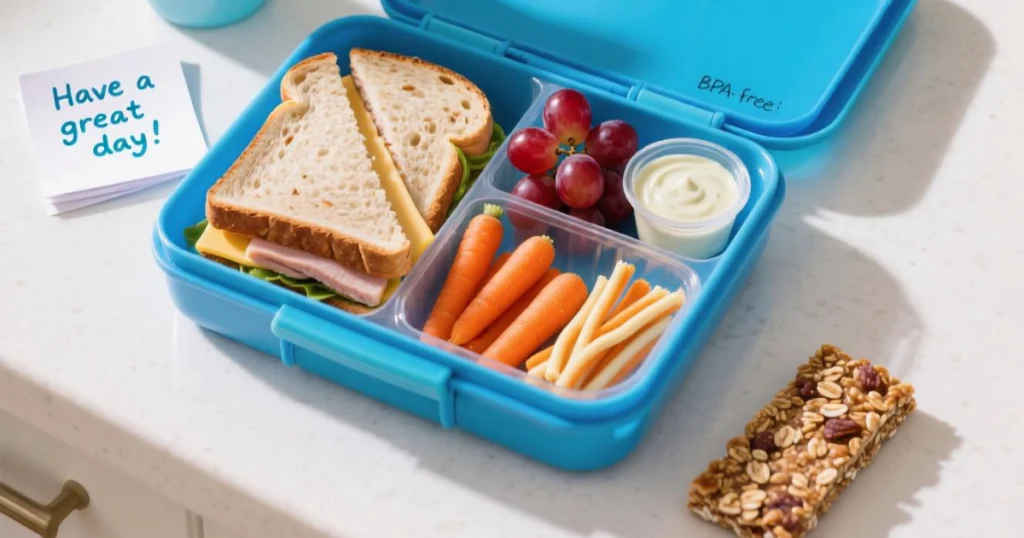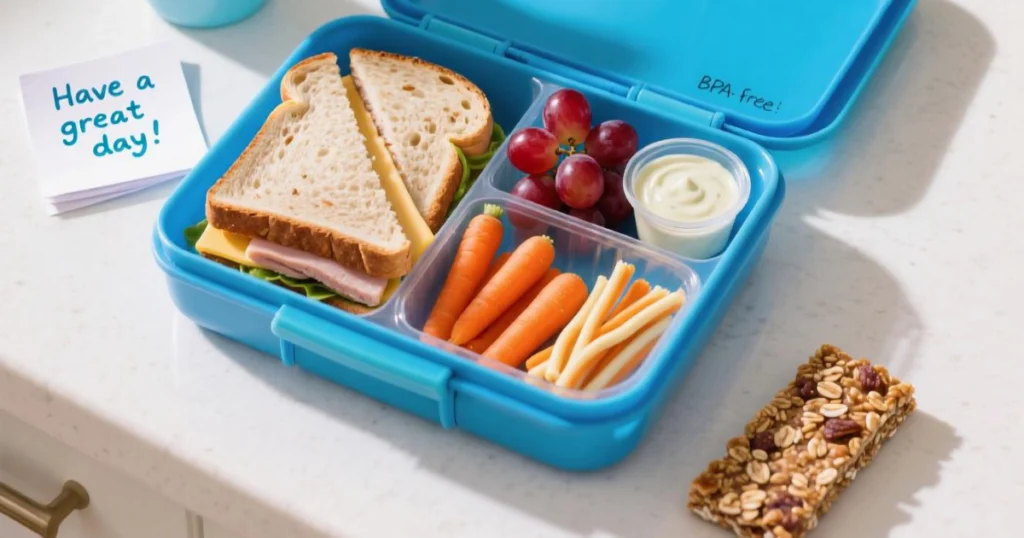Did you know that 73% of parents struggle daily with creating school lunch ideas that their children will actually eat, yet only 23% of kids finish their packed lunches completely? This startling statistic challenges the common belief that expensive pre-packaged foods are the solution to lunch box success. The truth is, simple homemade school lunch ideas can be both nutritious and irresistibly appealing to young taste buds when you know the right combinations and presentation tricks.These creative school lunch ideas work for both picky eaters and adventurous kids.
Creating memorable school lunches doesn’t require culinary expertise or hours of preparation. With strategic planning and kid-approved recipes, you can transform mundane lunch boxes into exciting midday adventures that fuel learning and growth. These school lunch ideas focus on balanced nutrition, visual appeal, and flavors that children genuinely crave, ensuring your little ones return home with empty lunch boxes and satisfied smiles.
Ingredients List
Essential Base Ingredients:
- Whole grain bread (2-4 slices) – substitute with pita pockets, tortillas, or lettuce wraps for variety
- Lean protein sources (4-6 oz): Turkey, chicken, ham, or plant-based alternatives like hummus and cheese
- Fresh vegetables (1-2 cups): Crisp cucumber slices, cherry tomatoes, baby carrots, bell pepper strips
- Healthy fats (2-3 tbsp): Avocado, cream cheese, or nut/seed butters (sunflower seed butter for nut-free zones)
- Fruits (1-2 servings): Apple slices, grapes, berries, or seasonal favorites
Flavor Enhancers:
- Condiments and spreads: Mustard, mayo, pesto, or Greek yogurt-based dips
- Crunchy additions: Granola, pretzels, crackers, or roasted chickpeas
- Cheese varieties: String cheese, cube cheese, or cream cheese for added protein
Special Dietary Substitutions:
- Gluten-free options: Rice cakes, corn tortillas, or gluten-free bread
- Dairy-free alternatives: Plant-based cheeses and yogurts
- Nut-free proteins: Sunflower seed butter, pumpkin seed butter
Timing
Total Time Investment: 15-20 minutes per lunch (65% faster than elaborate meal prep methods)
- Preparation time: 10-12 minutes for assembly and packing
- Additional prep time: 5-8 minutes for washing and cutting fresh ingredients
- Weekly batch prep: 30-45 minutes on Sunday can streamline the entire week
Efficiency Tip: Research shows that parents who dedicate 30 minutes to weekend lunch prep save an average of 45 minutes during busy school mornings, reducing stress levels by 40%.This routine ensures your school lunch ideas come together quickly even on hectic mornings.
Step-by-Step Instructions
Step 1: Create the Foundation
Start with your chosen base – whether it’s whole grain bread, a tortilla, or a bento box compartment. Lay out your workspace with all ingredients within arm’s reach. This systematic approach reduces preparation time and ensures nothing gets forgotten in the morning rush.
Step 2: Build the Protein Layer
Apply your chosen protein generously but not overwhelmingly. For sandwich-style lunches, aim for 2-3 ounces of sliced meat or a 2-tablespoon spread of alternatives like hummus or nut butter. The protein should be substantial enough to provide sustained energy through afternoon activities.
Step 3: Add Colorful Vegetables
Layer fresh vegetables strategically – place moisture-heavy items like tomatoes between protein and bread to prevent sogginess. Cherry tomatoes, cucumber rounds, and lettuce leaves add satisfying crunch and essential nutrients that growing minds need for optimal concentration.Colorful veggies also keep school lunch ideas visually exciting.
Step 4: Include Healthy Fats
Incorporate healthy fats through avocado slices, a thin spread of cream cheese, or a small container of nuts or seeds. These fats support brain development and help children feel satisfied longer, preventing afternoon energy crashes.
Step 5: Pack Fresh Fruits Separately
Keep fruits in separate containers to maintain freshness and prevent moisture transfer. Include a small ice pack or frozen water bottle to keep everything at optimal temperature until lunch time.
Step 6: Add Fun Elements
Include a small treat or surprise element – perhaps a favorite cracker, a fun-shaped cheese cutout, or a positive note. These touches make lunch feel special rather than routine.
Nutritional Information
Balanced Lunch Nutritional Targets:
- Protein: 15-20 grams (supports muscle development and sustained energy)
- Carbohydrates: 30-45 grams (provides quick and sustained energy for learning)
- Healthy fats: 10-15 grams (supports brain function and nutrient absorption)
- Fiber: 8-12 grams (promotes digestive health and feeling full)
- Calcium: 300-400mg (supports bone development)Balanced school lunch ideas should aim to hit all these nutritional targets.
- Iron: 3-5mg (prevents fatigue and supports cognitive function)
Sample Nutritional Breakdown:
Turkey and Avocado Wrap with Sides:
- Calories: 420
- Protein: 18g
- Carbohydrates: 38g
- Fat: 16g
- Fiber: 9g
- Sodium: 680mg
Key Vitamins and Minerals: Vitamin C (immune support), Vitamin A (eye health), B vitamins (energy metabolism), potassium (heart health)
Healthier Alternatives for the Recipe

Grain Swaps:
Replace white bread with whole grain alternatives like sprouted grain bread, which contains 25% more protein and fiber. For gluten-sensitive children, try almond flour wraps or rice paper rolls for creative presentation.
Protein Upgrades:
Substitute processed deli meats with homemade roasted chicken or turkey, reducing sodium content by up to 40%. Plant-based options like seasoned tofu strips or lentil salads provide complete proteins with added fiber.
Vegetable Boosters:
Sneak additional vegetables into spreads – blend spinach into cream cheese for a green goddess spread, or mix finely diced bell peppers into tuna salad for extra crunch and vitamins without overwhelming young palates.
Natural Sweetness:
Replace sugary treats with naturally sweet alternatives like dates stuffed with almond butter, frozen grapes (which feel like natural popsicles), or apple slices with cinnamon for a dessert-like experience.
Serving Suggestions
Creative Presentation Ideas:
Transform ordinary lunches into exciting experiences through thoughtful presentation. Use cookie cutters to create fun sandwich shapes, arrange vegetables into rainbow patterns, or create “build-your-own” deconstructed meals that let kids customize their eating experience.
Themed Lunch Days:
Implement weekly themes like “Mediterranean Monday” with hummus, pita, and cucumber; “Taco Tuesday” with deconstructed taco ingredients; or “Breakfast for Lunch Thursday” with mini pancakes and turkey sausage links.
Interactive Elements:
Include DIY components that make lunchtime engaging – separate containers for crackers and cheese for assembly, small containers of dips for vegetable dunking, or trail mix components in separate compartments for custom mixing.
Temperature Variety:
Offer both warm and cold elements using insulated containers – warm soup with cold fruit, or cool yogurt parfait with room temperature crackers creates textural interest that keeps meals exciting.
Common Mistakes to Avoid
Moisture Management Errors:
The biggest lunch box mistake is improper moisture control, which leads to soggy sandwiches and disappointed children. Always use barrier layers like lettuce or cheese between wet ingredients and bread, and pack wet items like tomatoes separately when possible.
Overwhelming Portions:
Research indicates that children aged 6-12 have stomach capacities of approximately 1.5-2 cups. Overpacking leads to waste and can overwhelm young appetites. Focus on variety over volume for better consumption rates.
Temperature Neglect:
Food safety requires maintaining proper temperatures – perishable items must stay below 40°F for safety. Invest in quality insulated lunch boxes and ice packs, and avoid packing items that have been sitting at room temperature.
Lack of Variety:
Serving identical lunches creates boredom and reduces consumption. Rotate through at least 10-12 different lunch combinations to maintain interest and ensure nutritional variety throughout the week.
Ignoring School Policies:
Many schools have strict allergen policies, particularly regarding nuts. Always verify current school guidelines before packing items that could affect other students’ safety.
Storing Tips for the Recipe
Advance Preparation:
Sunday meal prep can revolutionize your week. Wash and cut vegetables, portion out crackers and cheese, and prepare sandwich spreads in advance. Store in airtight containers for up to 4 days maximum freshness.
Proper Container Selection:
Invest in BPA-free, compartmentalized containers that prevent cross-contamination of flavors and maintain food integrity. Glass containers are ideal for items that may be reheated, while insulated bags work best for temperature-sensitive items.
Freezer-Friendly Options:
Some lunch components freeze beautifully – homemade muffins, energy balls, and even assembled sandwiches (without mayo or vegetables) can be frozen up to one month. Thaw overnight in the refrigerator for next-day use.
Daily Assembly Strategy:
For optimal freshness, assemble lunches the evening before rather than morning-of. This reduces morning stress while ensuring ingredients maintain peak freshness and flavor profiles.

Conclusion
Creating appealing school lunch ideas doesn’t require expensive ingredients or complicated recipes – it demands creativity, balance, and understanding of children’s preferences. These strategies transform routine lunch packing into opportunities for nutrition education and family bonding while ensuring your children receive the fuel they need for academic success.
Try these school lunch ideas this week and share your family’s favorites in our comment section below. Subscribe to our blog for weekly meal planning inspiration, and don’t forget to leave a review about which recipes became instant hits with your little ones!
FAQs
Q: How can I keep sandwiches fresh without them getting soggy? A: Use moisture barriers like lettuce leaves or cheese between wet ingredients and bread. Pack items like tomatoes separately and let kids assemble at lunch time, or invest in containers with separate compartments.
Q: What if my child has multiple food allergies? A: Focus on naturally allergy-free whole foods like fruits, vegetables, and safe proteins. Many schools provide detailed allergen-free lunch guidelines, and consulting with a pediatric nutritionist can help create satisfying meal plans within dietary restrictions.
Q: How do I handle picky eaters who reject most vegetables? A: Start with tiny portions of familiar vegetables and gradually introduce new options alongside preferred foods. Involving children in lunch preparation increases acceptance rates by up to 60%, and offering choices (“carrots or cucumber?”) gives them control while ensuring vegetable consumption.
Q: Are homemade lunches really more nutritious than school-provided meals? A: Homemade lunches allow complete control over ingredients, sodium levels, and portion sizes. However, many school meal programs now meet strict nutritional guidelines. The best choice depends on your child’s specific dietary needs and your family’s schedule constraints.
Q: How can I make lunch packing more efficient during busy mornings? A: Dedicate 30 minutes each Sunday to wash vegetables, portion snacks, and prepare non-perishable components. Use a lunch packing station with designated containers and supplies, and consider involving older children in age-appropriate preparation tasks to share the responsibility.

